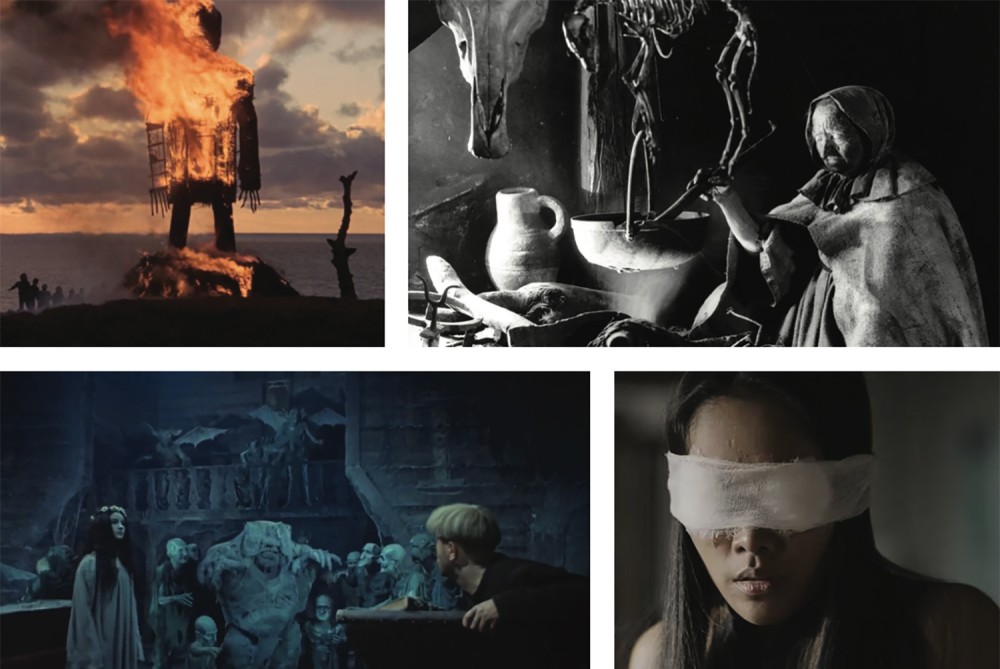The wisdom of folk horror
Around the world, filmmakers have used a horror framework to explore the fears and nightmares of their societies.

Some of the films featured in the documentary Woodlands Dark and Days Bewitched, clockwise from upper left: The Wicker Man, Häxan, Dearest Sister, Viy (British Lion Films, public domain, Lao Art Media, Mosfilm)
I’m a longtime aficionado of horror fiction, and I was floored by Kier-La Janisse’s staggeringly ambitious 2021 documentary Woodlands Dark and Days Bewitched. In its three-plus-hours running time, the film offers a sweeping survey of the genre of folk horror, touching on 200 films from all parts of the world. And even for those who are repelled by horror films in principle, the documentary opens the way quite surprisingly to discovering unexpected treasures on general religious themes, and specifically the theme of Christianity in the Global South. These films remind us of how faith must adapt to societies where older supernatural worlds are suppressed but by no means wholly exorcised.
The term “folk horror” was originally applied to British films that explored the idea that potent ancient forces and deep-rooted evils survive in the landscape, scarcely acknowledged by the modern world. Typically these dark forces are mobilized by sinister groups that deploy secret rituals dating from pre-Christian times. The plots commonly involve innocent outsiders entrapped in these fearsome proceedings and facing the prospect of a grisly sacrificial death. The best-known contribution is the 1973 film The Wicker Man, which regularly appears on critics’ lists of the three or four greatest British films ever made.
The basic mythology of British folk horror is totally fictitious in that such clandestine pagan networks never existed, or at least were in no sense survivals from ancient times—the belief that they were derives from a modern academic mythology. Even so, over the past 20 years, folk horror has become a huge academic topic, the subject of countless articles and conferences. Crucially, the genre offers a valuable way of looking at fictional productions from many countries around the world which use a broadly horror-oriented framework to explore the nightmares and fears of their own particular societies.
The original British films focused on the landscape’s dark secrets in the form of nonexistent witches. Other parts of the world have suppressed nightmares that are far more terrifying because they are literally true. The Guatemalan film La Llorona (2019) uses the familiar legend of the supernatural woman who weeps for her lost children, but the story focuses on the ruthless military massacres of Maya people in that country’s civil wars in the 1980s. A horror format becomes a vehicle for the exposure of real-world atrocities and memories of real evil.
Folk horror concerns the return of the repressed and excluded, and in the global context, the films often focus on the smoldering anger of Native and enslaved peoples, whose voices and beliefs were suppressed for so many centuries. Brazilian films like Noites de Iemanjá (1971) offer respectful treatment of African-derived mythologies as they resurface in the modern world. As modern scholars point out, the effectiveness of such films depends on the barely admitted feelings of guilt among the White people who constitute the social mainstream—and who see those darker-skinned people only in the context of supernatural fiction. In Australian contributions to the genre, such as The Last Wave (1977) and The Dreaming (1988), it is Aboriginal people who rise to protest past injustices and to offer apocalyptic warnings.
Such a resurgence is (or should be) of particular concern to the churches which have often appropriated the rituals and symbols of those Native and African peoples but which rarely acknowledge their role as accessories to injustices past and present. Interviewed in the Woodlands Dark documentary, Ojibwe journalist Jesse Wente remarks on the number of US folk horror films that are set on haunted Indian burial grounds. He says, “I sort of like it, because if non-Indigenous people are going to be afraid of the Indian burial ground, then I got some news for you. It’s all an Indian burial ground.” The ghosts really are there, and the haunting is genuine.
The folk horror genre often deploys the superstitions of a particular society, but with the warning that the menaces portrayed are literally true, whether they are shape-shifters or demonic forces. Such tales can be heard quite comfortably in the Global North, where they are sanitized as harmless fairy tales. They have a quite different resonance in African or Asian societies, where churches succeed or fail on the promises they offer of waging spiritual warfare against such beings. Flourishing Pentecostal megachurches must be thoroughly conversant with the varieties of local demons, of their prevention and cure. And witchcraft is still very much a live item on the Christian agenda.
Folk horror often illuminates the spiritual universes that ordinary people must navigate and in which they must seek aid from religious professionals. One fine Thai film, Nang Nak (1999), deals with the common dread that women who die in childbirth will return as quasi-vampiric creatures, haunting their families. The Philippine film The Rites of May (1976) likewise deals with these themes of spirits and possession, which again are treated as almost normal expectations of life (and death). The Laotian Dearest Sister (2016) uses the idea of mediumship and speaking with the dead as the basis for a larger meditation on contemporary dilemmas of Laotian identity, class, and gender. Very often, as in these examples, the fears and concerns are distinctively female.
If, by this point, you have deduced that the definition of folk horror is broad to the point of breaking, you are exactly right. On the positive side, you can spend many happy hours using the leads offered by Woodlands Dark and Days Bewitched to track down global films that are quite informative about different concepts of the spiritual universe, and by no means only in the Global South. I have been startled to realize just how many loosely defined “folk horror” films emerged from the former Soviet Union, including such classics as Viy (1967).
Folk horror is a strategy by which societies confront and exorcise their (literally) buried histories as they force their way back into contemporary spiritual consciousness. Or, in the words of that fine scholar of religion William Faulkner: “The past is never dead. It’s not even past.”



